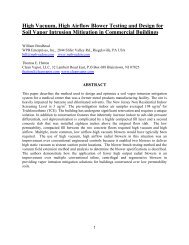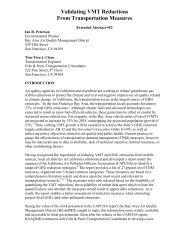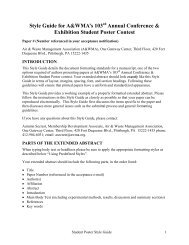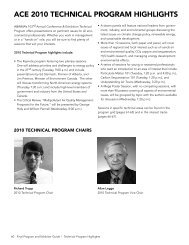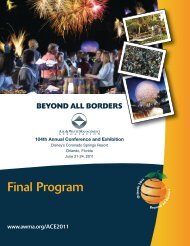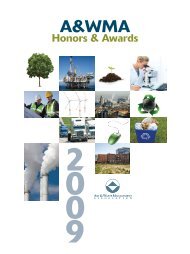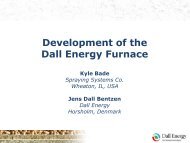Abstract Book
Abstract Book
Abstract Book
Create successful ePaper yourself
Turn your PDF publications into a flip-book with our unique Google optimized e-Paper software.
process, who have helped to define the city’s future.<br />
This methodology aims to help close the gap between ‘where we are now’ and ‘where we<br />
need to be’, which can be problematic given the all-encompassing nature of climate<br />
change and its cause, and the traditionally shorter-term policy making of local<br />
government. Given that approximately half the world’s population now lives in urban<br />
areas, rising to about 70% by 2050, and the IEA’s World Energy Outlook (2008)<br />
estimates the global energy-related carbon dioxide (CO2) emission contribution of cities<br />
is 71%, they are critical for effective mitigation.<br />
Improvement Of The Urban Design Model To Support Energy Efficiency And<br />
Reduce The Effects Of The Urban Heat Island Phenomenon (59)<br />
C. J. Watson, R. Peters; University of Alabama at Birmingham, Birmingham, AL<br />
Urban form has experienced various changes in past decades, once the most efficient<br />
model for living and working, through modern design has become our least. In this post<br />
industrial age we are finding that our urban design model is contributing to several<br />
adverse environmental effects. According to the Population Reference Bureau (PRB), in<br />
2007 50% of the world’s population resided in an urban area, with a predicted increase to<br />
53% in 2015 and 60% in 2030[1]. This expected population growth will have significant<br />
impacts on both energy and resource use. Modern urban design strategies have lead to<br />
significant increases in ambient air temperature (up to 22°F[2]) compared to surrounding<br />
rural areas, referred to as the urban heat island effect, and is the result of displacing trees<br />
and vegetation with hard surfaces (building facades and paved roads).<br />
This project will analyze the city of Birmingham, Alabama in the following area; 1)<br />
building materials, 2) building codes used for construction, 3) age of urban infrastructure,<br />
4) comparison of rural and urban ambient temperatures, 5) surface temperatures (green<br />
space, paved areas, building facades, and roofs), 5) investigate the impacts of the city<br />
block and how its components/characteristics influence shading effects, exposure to<br />
sunlight, and cooling and heating effects, and 6) analysis of city characteristics (zoning,<br />
land use patterns and population). This data will provide the base reference material to<br />
provide retrofit improvements for existing cities and suggestions for new urban<br />
construction in the United States.<br />
[1] http://www.prb.org/Articles/2007/UrbanPopToBecomeMajority.aspx<br />
[2] Environmental Protection Agency<br />
(http://www.epa.gov/climate4action/learn/glossary.htm)<br />
Greywater Characterization In Saudi Arabia (117)<br />
A. O. Al-Jasser, S. M. Mogren; King Saud University, Riyadh, Saudi Arabia<br />
Water conservation and the use of reclaimed wastewater are currently being considered<br />
as strategic solutions to limited water supplies in Saudi Arabia and other arid and semiarid<br />
countries. Greywater is non-industrial wastewater generated from domestic sources;<br />
it includes drainage water from showers, baths, hand-washing sinks and washing<br />
machines. Greywater, which does not include toilet wastewater (known as blackwater),<br />
20




